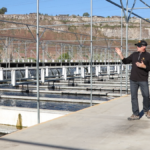
Chlorpyrifos: What We Know Today
An item has popped up in the news and we’ve received a few questions about it. The topic is chlorpyrifos – a pesticide that is used in many places, including homes, golf courses and farms. The issues involved are complex, so we wanted to take a look at some questions we’ve received.
What is chlorpyrifos?
Chlorpyrifos is a chemical compound in the category known as organophosphates, which explains the hard-to-pronounce name (sounds like clohr-PEER-uh-fos). It is sold under the trade names Lorsban, Warhawk and others.
Chlorpyrifos is an insecticide that is used to kill insects that feed on plants, trees or animals, and it has been used since 1965. For household use, chlorpyrifos is found in roach and ant bait stations in child-resistant packaging. The Environmental Protection Agency states that chlorpyrifos is used on more than 50 crops, including apples, asparagus, onions, grapes, almonds, broccoli, cherries, oranges, corn and soybeans. It is also used to kill insects on golf courses, greenhouses and utility poles.
Organophosphates are rapidly broken down into other chemicals so they do not build up in the environment, according to the Centers for Disease Control. They are not likely to build up to high or dangerous levels in animal or plant foods.
What are the concerns?
Organophosphates work by affecting the nervous system of insects. They can also impact humans, which is why all pesticides carry this statement on the label: “It is a violation of Federal law to use this product in a manner inconsistent with its labeling.”
Regulatory agencies routinely monitor pesticides for safety. Since 2000, the EPA changed some of the regulations about how chlorpyrifos can be used. Studies have examined the safety of the insecticide. According to the National Pesticide Information Center, chlorpyrifos exposure was linked to developmental delays in young laboratory animals. This study was conducted on laboratory animals and not on humans. Factcheck.org notes that some studies conducted by Columbia Center for Children’s Environmental Health do suggest that exposure to chlorpyrifos can lead to development issues in children, but they are correlational studies and do not provide causal links. Read about the difference between causation and correlation.
Last year, the EPA’s scientific advisory panel raised several questions about the methods used in one of the studies.
What is the latest?
The EPA had been considering further restrictions on uses of chlorpyrifos. On March 29, 2017, the EPA determined that based on the evidence available, chlorpyrifos could continue to be applied for the uses that have previously been approved. The safety of the chemical will continue to be studied.
“We will continue to evaluate the potential risks posed by chlorpyrifos as part of the ongoing registration review and intend to complete our assessment by the statutory deadline of Oct. 1, 2022,” the agency stated.
Chlorpyrifos is not approved for domestic use in Canada.
At Best Food Facts, we will continue to follow this topic and provide an update when it develops.

























